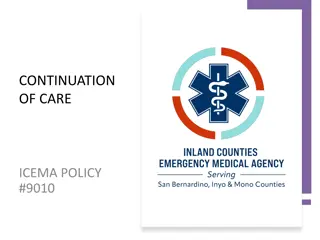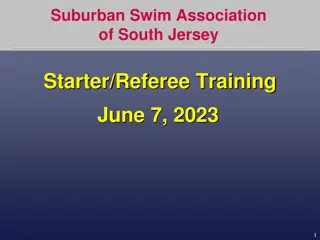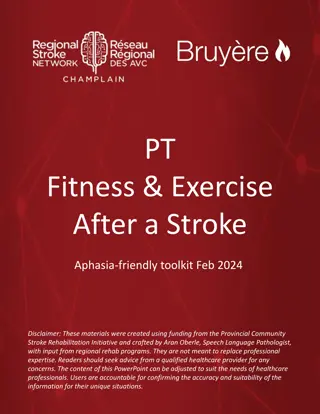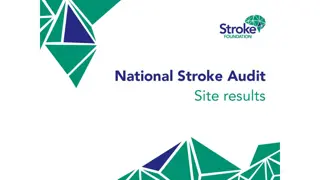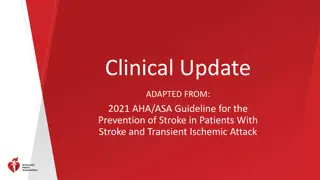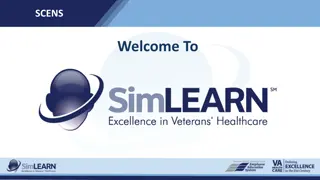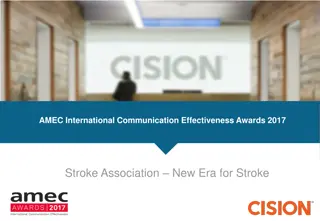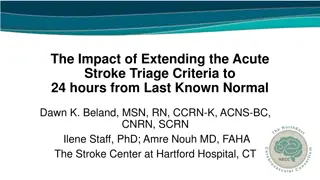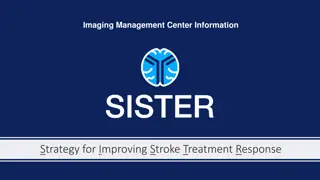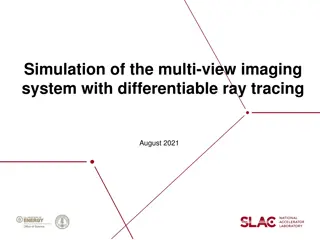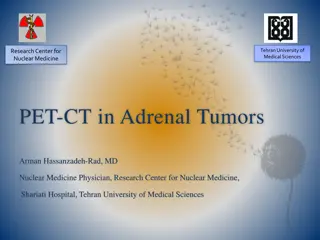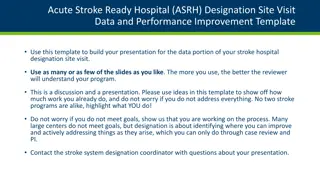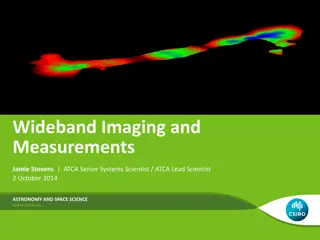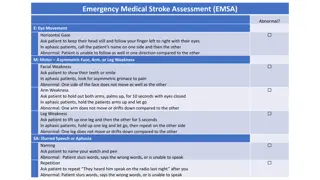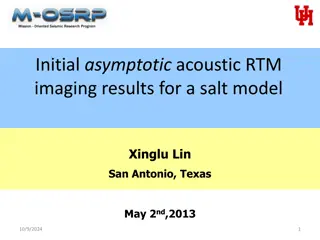Automated CT Perfusion Imaging in Acute Ischemic Stroke: Overview
This presentation delves into the significance of automated CT perfusion imaging in diagnosing and treating acute ischemic stroke. It covers essential information such as the burden of stroke in Ontario, the critical aspect of time in stroke treatment, hyperacute stroke treatment goals, and the impo
4 views • 41 slides
ICEMA Policy #9010: Continuation of Care for Urgent Patient Transfer
This policy outlines the procedures for rapid transport and transfer of patients requiring urgent care to Specialty Care Centers by ICEMA Continuation of Care EMS Providers and Referral Hospitals. It includes criteria for Specialty Care Centers acceptance of trauma, STEMI, and stroke patients, desig
1 views • 28 slides
Basic Principles of MRI Imaging
MRI, or Magnetic Resonance Imaging, is a high-tech diagnostic imaging tool that uses magnetic fields, specific radio frequencies, and computer systems to produce cross-sectional images of the body. The components of an MRI system include the main magnet, gradient coils, radiofrequency coils, and the
2 views • 49 slides
Swimming Stroke Rules and Regulations Training
Learn about the rules and regulations of swimming strokes, including backstroke and breaststroke techniques. The training covers key aspects such as stroke review, host and visiting team responsibilities, meet officials' duties, and scorekeeping. Understand the specifics of backstroke starts, finish
4 views • 50 slides
Radiographic Imaging Methods of the Respiratory System
Radiographic imaging plays a crucial role in the evaluation and diagnosis of thoraco-mediastino-pleuro-pulmonary conditions. Techniques like radioscopy, digital radiography, computer tomography, magnetic resonance imaging, conventional pulmonary angiography, and hybrid imaging methods offer detailed
10 views • 21 slides
Understanding Basic CT Perfusion Terms in Stroke Imaging
This educational content delves into fundamental concepts related to CT perfusion imaging in stroke evaluation. It covers key terms such as core infarct, penumbra, Time to Peak, Mean Transit Time, Cerebral Blood Volume, and more. The information includes definitions, descriptions, and the significan
6 views • 16 slides
SALIVARY GLAND IMAGING
Salivary gland imaging plays a crucial role in diagnosing and monitoring diseases of the major salivary glands, including the parotid, submandibular, and sublingual glands. Different imaging techniques such as computed tomography, MRI, and ultrasound are used to visualize these glands and aid in dif
1 views • 12 slides
SISTER Study: Improving Stroke Treatment Response with TS23
SISTER Study led by Eva Mistry aims to identify a safe and effective dose of TS23 for treating ischemic stroke patients with core-penumbra mismatch. The Phase-2 trial involves 300 adults and spans 54 months, with primary endpoints focusing on treatment efficacy and safety. The study is randomized, p
0 views • 22 slides
Fitness and Exercise After Stroke: Importance and Guidelines
Understanding the importance of fitness and exercise in stroke recovery is crucial due to the varied challenges individuals face post-stroke. This toolkit provides information on the impact of stroke, the benefits of exercise, types of exercises recommended, and different exercise program options av
2 views • 11 slides
Hospital Stroke Care Audit 2023 Presentation
Customize your hospital's stroke care audit presentation using the provided template. Add your hospital's data to create an interactive slide deck for sharing with your team and stakeholders. The National Stroke Audit Acute Services 2023 focuses on assessing resources and clinical care indicators ag
23 views • 15 slides
Clinical Update: 2021 AHA/ASA Guideline for Stroke Prevention
This clinical update provides guidance adapted from the 2021 AHA/ASA Guideline for the Prevention of Stroke in Patients with Stroke and Transient Ischemic Attack. It categorizes recommendations based on strength and quality of evidence, outlining levels of recommendation and evidence for different c
0 views • 43 slides
Comprehensive Guide to Stroke Care: SCENS Protocol Overview
This comprehensive guide delves into the SCENS protocol for stroke care, covering learning objectives, reasons for implementation, major stroke types, risk factors, the 8 Ds of stroke care, important time goals, and the FAST assessment process. It emphasizes the importance of early detection, swift
2 views • 20 slides
Comprehensive Stroke Program Orientation for Medical Staff - Facts and Objectives
The Comprehensive Stroke Program provides crucial information for medical staff, covering acute stroke response, available stroke codes, and responsibilities during inpatient care. Stroke facts highlight the prevalence, causes, risk factors, and complications associated with strokes. Details on lacu
0 views • 22 slides
Diagnostic Reference Levels in Medical Imaging and Radiation Protection
The concept of Diagnostic Reference Levels (DRLs) is crucial in evaluating the amount of ionizing radiation used in medical imaging procedures. DRLs help determine if radiation levels are appropriate and need optimization. Authorized bodies establish numerical DRL values as advisory guidelines. Loca
1 views • 26 slides
Australian Imaging Biomarkers and Lifestyle Study: Progress and Focus
The Australian Imaging Biomarkers and Lifestyle Study of Ageing (AIBL) commenced in late 2006, with a cohort size and follow-up progress detailed. The study includes assessments and biomarker imaging, such as MRI, amyloid PET, and tau PET scans, with ongoing review cycles and data additions. Current
0 views • 12 slides
Stroke Association Campaign: Driving Change for Stroke Awareness
The Stroke Association's campaign aimed to raise awareness and lobby the government for a new stroke strategy. Through strategic communication efforts, including petitions, media engagement, and famous landmarks turning purple, the campaign successfully reached key audiences, gained petition signatu
0 views • 5 slides
Understanding Stroke-Specific Etiologies and Interventions for Falls in Inpatient Rehabilitation
Falls are a common complication after stroke, leading to hip fractures and various secondary complications. Inpatient rehabilitation often focuses on interventions to reduce stroke-related falls, considering factors like muscle tone, cognitive impairments, and balance deficits. Understanding these s
1 views • 27 slides
Impact of Extending Acute Stroke Triage Criteria to 24 Hours
Landmark trials have extended the therapeutic time window for mechanical thrombectomy for acute ischemic stroke patients. This study evaluates the impact of implementing a protocol change to extend the time window at a comprehensive stroke center. Retrospective analysis compared stroke alerts and ke
1 views • 8 slides
Advances in Anticoagulation Therapy for Cancer-Related VTE and Stroke
Recent studies have shown advancements in anticoagulation therapy for cancer patients with venous thromboembolism (VTE) and stroke prevention. Direct oral anticoagulants (DOACs) are now considered beneficial for treating VTE in cancer, offering advantages in administration and efficacy. Different an
3 views • 9 slides
Enhancing Stroke Treatment Response Through Advanced Imaging Management Center Strategy
This information details the strategy proposed by the Imaging Management Center to improve stroke treatment response. It emphasizes the importance of timely uploading of brain imaging data within specified timeframes using the AMBRA platform. The process involves modalities like NCCT, CTA, MRI, and
0 views • 6 slides
Evaluation of Risk Stratification Schemes for Ischaemic Stroke and Bleeding in Atrial Fibrillation Patients
A study conducted in Sweden on 182,678 patients with atrial fibrillation aimed to investigate risk factors for stroke and bleeding. The research assessed the application of CHA2DS2-VASc and HAS-BLED schemes for stroke and bleeding risk evaluations. Data from the Swedish Atrial Fibrillation cohort st
0 views • 20 slides
Understanding Ionizing Radiation in Medical Imaging
Radiation in medical imaging plays a critical role in diagnosis and treatment but also poses risks to patients and healthcare workers. Ionizing radiation, used in various imaging modalities, can cause harm to healthy cells if not managed properly. This article discusses the implications of radiation
0 views • 54 slides
Sparse Millimeter-Wave Imaging Using Compressed Sensing and Point Spread Function Calibration
A novel indoor millimeter-wave imaging system based on sparsity estimated compressed sensing and calibrated point spread function is introduced. The system utilizes a unique calibration procedure to process the point spread function acquired from measuring a suspended point scatterer. By estimating
2 views • 26 slides
Portal Vein Imaging Techniques and Anomalies Overview
Portal vein imaging is crucial for evaluating conditions affecting the abdominal part of the gastrointestinal tract. Techniques such as spleno-portography and CT triphasic contrast imaging are used to visualize the portal vein and diagnose anomalies like portal-systemic collaterals and porto-systemi
4 views • 7 slides
Introduction to Radiology: Imaging Modalities and Techniques
Radiology is a medical specialty that utilizes various imaging modalities such as X-Ray, MRI, CT, and Ultrasound to diagnose and treat patients. This field involves the supervision, performance, and interpretation of imaging studies, with findings reported to referring physicians. Radiology also inv
0 views • 10 slides
Managing Eating and Swallowing Challenges After Stroke
Dysphagia, a common issue after a stroke, can lead to difficulty swallowing and may require texture modifications in food and fluids for safety. Up to 65% of stroke survivors may experience dysphagia, which can lead to complications like pneumonia. Proper oral care, mealtime positioning, and awarene
0 views • 9 slides
Stroke Recovery Peer Support Program Guidelines
Learn about the "Peers Fostering Hope Supported by the Dr. Ed & Bobby Yielding Fund for Stroke Recovery" initiative aiming to re-engage and re-integrate stroke survivors into the community. Explore how peer visitors provide support, encouragement, and hope for community re-engagement and reintegrati
1 views • 16 slides
Advanced Microscopy Techniques in EUV Lithography: SHARP Overview
SHARP utilizes Fresnel zone plate lenses to achieve diffraction-limited quality in EUV lithography, offering a range of NA values and image magnifications. The system allows emulation of mask-side imaging conditions with hundreds of lenses available. Coherence control and engineering are provided th
1 views • 18 slides
Insights into Multi-View Imaging System Optimization
Delve into the simulation and calibration of a multi-view imaging system using differentiable ray tracing and gradient-based optimization. Explore the challenges of ambiguity in results and the impact of angular offset on imaging accuracy. Discover how the system handles errors and maintains precise
0 views • 6 slides
Understanding PET-CT Imaging in Adrenal Tumors at Tehran University
Tehran University of Medical Sciences' Research Center for Nuclear Medicine specializes in PET-CT imaging for adrenal tumors. Dr. Arman Hassanzadeh-Rad, MD, explains the principles of PET imaging, hybrid imaging combining PET and CT, F-18 FDG use, SUV measurement, and more. PET-CT allows for both at
0 views • 21 slides
Enhancing Stroke Program Performance: ASRH Designation Site Visit Data & Improvement
Explore the data presentation template for an Acute Stroke Ready Hospital (ASRH) designation site visit, focusing on key metrics like door-to-activation times and imaging procedures. Evaluate trends, showcase improvements, and address future plans for quality enhancement. Consider additional trackin
0 views • 11 slides
Simulation Study of Photoacoustic Imaging for Bragg Peak Reconstruction
This study explores the use of simulation in Photoacoustic Imaging for reconstructing the Bragg peak in proton therapy. It discusses the concept of Photoacoustic Imaging, the generation of acoustic waves from pulsed electromagnetic radiation, and the experimental setups for characterizing proton dos
0 views • 13 slides
Overview of Radiography and Ultrasound Imaging Techniques
This content provides a comprehensive overview of conventional radiography, digital radiography, and ultrasound imaging techniques. It covers equipment details, safety issues, advantages vs. limitations, as well as the interpretation, magnification, and integration capabilities of these imaging moda
0 views • 28 slides
Understanding Magnetic Resonance Imaging (MRI)
Magnetic Resonance Imaging (MRI) is an imaging technique based on nuclear magnetic resonance principles. It was first developed in the 1970s by Paul Lauterbur and Peter Mansfield. MRI uses the interaction between protons in the body and magnetic fields to create detailed images. This technology has
0 views • 77 slides
Comprehensive Radiological Imaging Review in Abdominal and Adrenal Pathologies
This extensive radiological imaging review covers a wide range of topics in abdominal and adrenal pathologies, discussing differential diagnoses, imaging modalities such as CT and USG, specific syndromes like prune belly syndrome, and conditions like retroperitoneal fibrosis. It delves into various
0 views • 39 slides
Wideband Imaging and Measurements in Astronomy
Wideband imaging and measurements play a crucial role in astronomy and space science. This involves utilizing wide bandwidths to make accurate measurements and create images for continuum mapping and spectral-line observations. Increasing bandwidth enables lower thermal noise levels, quicker identif
0 views • 32 slides
Overview of DICOM WG21 Multi-Energy Imaging Supplement
The DICOM WG21 Multi-Energy Imaging Supplement aims to address the challenges and opportunities in multi-energy imaging technologies, providing a comprehensive overview of imaging techniques, use cases, objectives, and potential clinical applications. The supplement discusses the definition of multi
0 views • 33 slides
Emergency Medical Stroke Assessment (EMSA) Abnormal Signs & Evaluation
This comprehensive guide outlines the Emergency Medical Stroke Assessment (EMSA) protocol for assessing potential stroke patients. It covers the evaluation of abnormal signs related to eye movement, motor weaknesses in the face, arms, and legs, as well as slurred speech or aphasia. The assessment in
0 views • 9 slides
Understanding Initial Asymptotic Acoustic RTM Imaging Results in Salt Model
Acquire insights into the initial asymptotic acoustic RTM imaging results for a salt model in Xinglu Lin, San Antonio. This study delves into the concept of Reverse Time Migration (RTM), showcasing the methodology, workflow, and imaging conditions involved in this innovative seismic imaging techniqu
0 views • 22 slides
Stroke Continence Protocols for Managing Bladder and Bowel Function After Stroke
This protocol outlines the management of urinary and bowel incontinence in stroke patients, emphasizing high nursing care levels and avoiding unnecessary catheterization. It discusses normal bladder functions, urinary dysfunction prevalence post-stroke, and interventions for promoting continence. Ur
0 views • 30 slides

